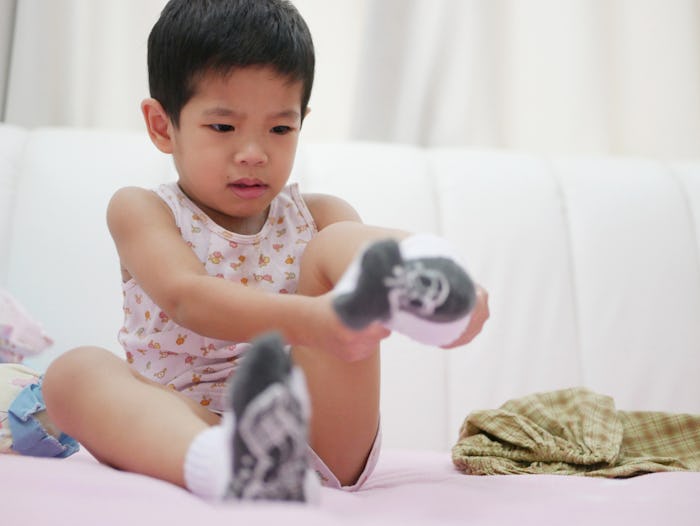Life

Here's Why Making Your Kids Put On Socks Is Such A Battle, According To Experts
I hated wearing socks as a kid. I would kick and scream, telling my mom that socks made my feet “tingle” over and over again. While I did outgrow my sock woes, the battle over wearing socks is one many parents struggle with. When a kid won’t wear socks, parents are often left scratching their heads as to why. The answer depends on the individual child.
Like it or not, kids have to wear socks for a myriad of reasons. Many school dress codes, including my own child’s preschool, require closed-toed athletic shoes in order to ensure the safety of students who are running and playing throughout the course of the day. Without socks, blisters happen, so they become a necessary part of getting dressed daily. Not to mention adding a protective layer for feet and lower legs when it’s cold out.
One reason kids may dislike wearing socks could have to do with sensory processing. The Child Mind Institute listed refusing to wear certain clothing as a sign of hypersensitivity in some children on their website. They wrote that when certain clothing items are bothersome for a sensitive child, a tantrum can ensue. As frustrating as this may be for parents, the tantrum is a sensitive child’s way of communicating that there is overstimulation occurring. In this case, that’s a sock that doesn’t feel quite right.
Addressing these sensory needs is important for overall child development, according to Maureen Healy, author of The Emotionally Healthy Child. “The highly sensitive child needs to be supported physically, mentally, socially, and emotionally. Since her feelings are more intense than her peers and reactions oftentimes match, it benefits parents to help her slow down, feel her feelings, and make smarter choices,” Healy says in an interview with Romper.
Healy advises acknowledging a child’s sensitivity to clothing such as socks, and taking steps to find what is comfortable for them. “By removing challenges such as uncomfortable socks and partnering with your child to find comfortable ones, things will go easier and she’ll feel acknowledged, supported, and heard, which is what she needs,” Healy says.
So, in this instance, finding the right sock for sensitive children may be one solution. Trying out seamless socks, socks made from different materials, or socks that are low-cut instead of hitting above the ankle could all be the answer to removing an aggravating sensory stimulant. This was definitely the case with me as a child. Only one brand of socks seemed to not irritate my sensitive feet, but they were pricey and my parents couldn’t afford them, so my sweet grandmother stepped in to keep my wardrobe well-stocked with my favorite socks to avoid daily meltdowns.
Healy does acknowledge however that this is not always a quick and easy solution, and it will take work to make the sock struggle disappear. “Of course, there are moments when we cannot find the 'right' sock or 'top' but with some work upfront — those days will be fewer and fewer,” she says.
But not every child's sock tantrum has to do with sensitivity. Another reason children may be struggling with socks has to do with asserting their independence. In an interview by Heidi Stevens with the Chicago Tribune, clinical psychologist and author Wendy Mogel speaks to the notion of sock refusal as a form of rebellion. “Parents find themselves caught in a situation where kids are saying, 'You can make me do a lot of things, but you can’t make me put on my socks,'” Mogel told Stevens.
I know my own strong-willed preschooler sometimes wants to wear the socks he wants when he wants, and no amount of begging or pleading will get him to change his mind. Mogel asserts that this can be a by-product of too little personal responsibility given to children today.
Parenting experts often agree that giving children some responsibility in selecting their clothing can go a long way when attempting to head off potential meltdowns. So letting your 4-year-old wear bright purple socks with their red sneakers instead of the white ones that you would choose may seem like a fashion nightmare to you, but it could potentially save you and your child from the dreaded morning meltdown.